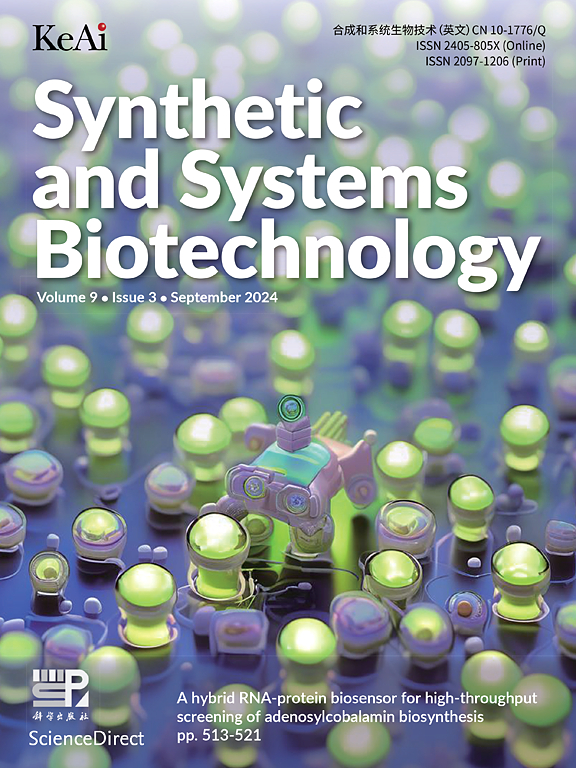在球形红杆菌HY01中,PrrAB系统激活增强和法尼脂基焦磷酸转移受限是辅酶Q10高积累的基础
IF 4.4
2区 生物学
Q1 BIOTECHNOLOGY & APPLIED MICROBIOLOGY
引用次数: 0
摘要
工业球形红杆菌HY01积累了异常高水平的辅酶Q10 (Q10),但其潜在的机制尚不完全清楚。鉴于Q10在呼吸电子传递中的核心作用,先前观察到HY01中cbb3型细胞色素c氧化酶基因表达减少,表明可能存在潜在的机制联系。在本研究中,我们发现HY01的cbb3氧化酶活性仅为野生型2.4.1的21.8 - 32.8%,恢复该活性导致Q10积累减少64.4%,表现出很强的负相关关系。这种相关性被发现是通过激活PrrAB双组分调控系统介导的,该系统由cbb3氧化酶负调控。然而,仅在2.4.1中破坏cbb3氧化酶不足以重现高Q10积累表型,这表明可能需要其他因素。先前的研究还发现,在HY01中,geranylgeranyl diphosphate (GGPP)的合成受到限制,这可能减少了Q10前体farnesyl diphosphate (FPP)的转移。在野生型菌株中重建这种代谢约束,并结合PrrAB系统激活的微调,导致Q10积累增加了218.0%,达到与HY01几乎相同的水平。本研究结合机制研究和逆向代谢工程研究,证明了在HY01中Q10的高积累是PrrAB激活增强和FPP转移受限的协同作用的结果,为探究球棘草Q10高积累的关键因素提供了新的见解。本文章由计算机程序翻译,如有差异,请以英文原文为准。
Enhanced PrrAB system activation and restricted farnesyl pyrophosphate diversion underlie high coenzyme Q10 accumulation in Rhodobacter sphaeroides HY01
The industrial Rhodobacter sphaeroides HY01 accumulates an exceptionally high level of coenzyme Q10 (Q10), but the underlying mechanisms remain incompletely understood. Given the central role of Q10 in respiratory electron transport, previous observation of reduced expression of cbb3-type cytochrome c oxidase genes in HY01 suggested a potential mechanistic link. In this study, we found that cbb3 oxidase activity in HY01 was only 21.8–32.8 % of that in the wild-type 2.4.1, and restoring this activity led to a 64.4 % decrease in Q10 accumulation, demonstrating a strong inverse correlation. This correlation was found to be mediated by the activation of the PrrAB two-component regulatory system, which is negatively regulated by cbb3 oxidase. However, disruption of cbb3 oxidase in 2.4.1 alone was insufficient to reproduce the high Q10 accumulation phenotype, indicating that additional factors may be required. Previous research also revealed restricted synthesis of geranylgeranyl diphosphate (GGPP) in HY01, which likely reduces the diversion of the Q10 precursor farnesyl diphosphate (FPP). Reconstituting this metabolic constraint in wild-type strain, combined with fine-tuning of PrrAB system activation, resulted in up to a 218.0 % increase in Q10 accumulation, achieving a level nearly identical to HY01. Combining mechanistic investigation and inverse metabolic engineering, this study demonstrates that the high Q10 accumulation in HY01 results from the synergistic effects of enhanced PrrAB activation and restricted FPP diversion, providing new insights into the key factors underlying high-level Q10 accumulation in R. sphaeroides.
求助全文
通过发布文献求助,成功后即可免费获取论文全文。
去求助
来源期刊

Synthetic and Systems Biotechnology
BIOTECHNOLOGY & APPLIED MICROBIOLOGY-
CiteScore
6.90
自引率
12.50%
发文量
90
审稿时长
67 days
期刊介绍:
Synthetic and Systems Biotechnology aims to promote the communication of original research in synthetic and systems biology, with strong emphasis on applications towards biotechnology. This journal is a quarterly peer-reviewed journal led by Editor-in-Chief Lixin Zhang. The journal publishes high-quality research; focusing on integrative approaches to enable the understanding and design of biological systems, and research to develop the application of systems and synthetic biology to natural systems. This journal will publish Articles, Short notes, Methods, Mini Reviews, Commentary and Conference reviews.
 求助内容:
求助内容: 应助结果提醒方式:
应助结果提醒方式:


